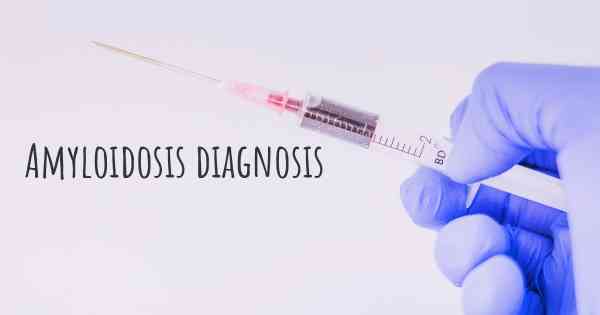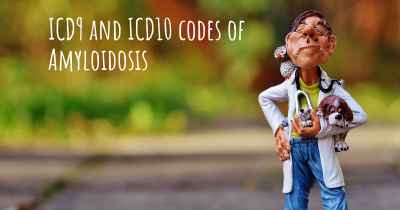How is Amyloidosis diagnosed?
See how Amyloidosis is diagnosed. Which specialists are essential to meet, what tests are needed and other useful information for the diagnosis of Amyloidosis

How is Amyloidosis Diagnosed?
Amyloidosis is a rare disease characterized by the abnormal accumulation of amyloid proteins in various organs and tissues of the body. It can affect multiple organs, including the heart, kidneys, liver, and nervous system. Early diagnosis of amyloidosis is crucial for effective management and treatment of the condition. The diagnostic process typically involves a combination of clinical evaluation, laboratory tests, imaging studies, and tissue biopsy.
Clinical Evaluation:
The first step in diagnosing amyloidosis involves a thorough clinical evaluation by a healthcare professional. The doctor will review the patient's medical history, including any symptoms experienced, family history of amyloidosis, and any underlying conditions that may be associated with the disease. The doctor will also perform a physical examination to assess the patient's overall health and look for signs of amyloidosis, such as organ enlargement or abnormal skin findings.
Laboratory Tests:
Laboratory tests play a crucial role in the diagnosis of amyloidosis. Blood and urine tests are commonly used to detect and analyze specific proteins that may indicate the presence of amyloid deposits. These tests may include:
- Complete Blood Count (CBC): This test measures the levels of different blood cells and can help identify abnormalities associated with amyloidosis, such as anemia or low platelet count.
- Liver and Kidney Function Tests: These tests assess the functioning of the liver and kidneys, as amyloid deposits can affect these organs. Abnormalities in liver or kidney function may suggest the presence of amyloidosis.
- Immunofixation Electrophoresis: This test helps identify abnormal proteins in the blood or urine that may be indicative of amyloidosis.
- Bone Marrow Biopsy: A bone marrow biopsy may be performed to evaluate the presence of abnormal plasma cells, which can be associated with certain types of amyloidosis.
Imaging Studies:
Imaging studies are often used to assess the extent of organ involvement and to identify any structural abnormalities caused by amyloid deposits. These studies may include:
- Echocardiogram: This ultrasound test evaluates the structure and function of the heart, helping to identify any abnormalities or signs of cardiac amyloidosis.
- Electrocardiogram (ECG): An ECG records the electrical activity of the heart and can detect any irregularities or abnormalities associated with amyloidosis.
- Magnetic Resonance Imaging (MRI): MRI scans can provide detailed images of the organs and tissues affected by amyloidosis, aiding in the diagnosis and assessment of the disease.
- Computerized Tomography (CT) Scan: CT scans use X-rays to create cross-sectional images of the body, helping to identify amyloid deposits in various organs.
Tissue Biopsy:
A definitive diagnosis of amyloidosis is typically made through a tissue biopsy, which involves obtaining a small sample of affected tissue for examination under a microscope. The biopsy can be performed on various organs, depending on the suspected site of amyloid deposition. Common biopsy sites include:
- Abdominal Fat Pad Biopsy: This minimally invasive procedure involves removing a small sample of fat tissue from just beneath the skin in the abdomen. The sample is then stained and examined for the presence of amyloid deposits.
- Rectal Biopsy: A rectal biopsy may be performed to obtain a sample of rectal tissue for analysis. This procedure is particularly useful in diagnosing a specific type of amyloidosis called hereditary ATTR amyloidosis.
- Organ Biopsy: In some cases, a biopsy of affected organs such as the kidney, liver, or heart may be necessary to confirm the presence of amyloid deposits and determine the specific type of amyloidosis.
Genetic Testing:
In certain cases, genetic testing may be recommended to identify specific gene mutations associated with hereditary forms of amyloidosis. This can help determine the underlying cause of the disease and guide treatment decisions.
It is important to note that the diagnostic process for amyloidosis may vary depending on the individual case and the suspected type of amyloidosis. A multidisciplinary approach involving various medical specialists, such as hematologists, cardiologists, nephrologists, and pathologists, is often necessary to ensure an accurate diagnosis and appropriate management of the disease.
USUALLY AFTER SEVERAL BIOPSIES AND cMRI
Posted Jul 11, 2019 by ESPERARE
Posted Mar 2, 2017 by Beth 1100
Posted Jun 3, 2017 by Nancy 2000
Posted Jul 19, 2017 by Phyllis 2000








